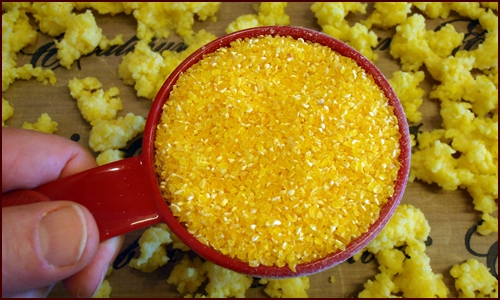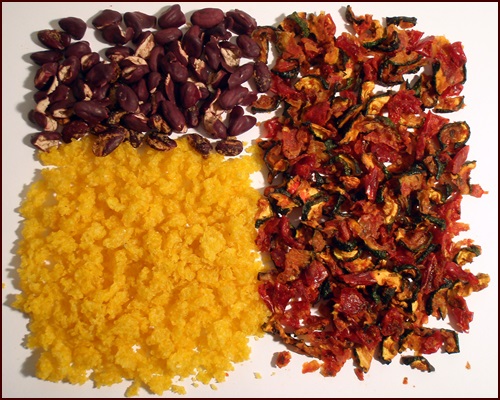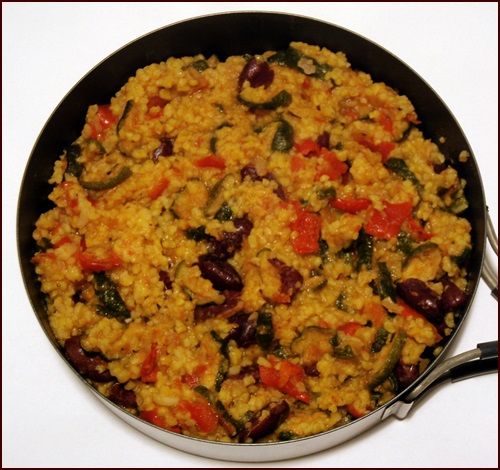| Back to Back Issues Page |
 |
|
January 2014 Trail Bytes: True Grits & Three Sisters Stew January 31, 2014 |
| Hello, In the last issue of Trail Bytes we covered how to make oat bark. One reader noted that you don’t need to precook and dry oatmeal since it cooks up just fine on the trail with a minute of boiling and waiting five minutes with the pot in a cozy. The usefulness of oat bark is for those folks who want to hit the trail in the morning without cooking, but still get all the nutrition of a bowl of oatmeal. If they change their mind, they can still rehydrate it with an equal quantity of boiled water for a bowl of hot and creamy oatmeal. I liked the taste of oat bark well enough that I plan to incorporate it into trail mix. I’m still looking for more submissions of trail mix recipes before I write up a webpage on the topic. Thanks to Michael F., Deborah B., Vance M., Rachel P., Peter R., and Joel N. for sharing your recipes. I'll include them when I write up the page. The winner of the Trail Mix Recipe Contest was Rachel Phelps and she gets a copy of my book, Recipes for Adventure. Rachel’s Trail Mix Recipe:
Dehydrating PolentaAfter working on oat bark, I moved on to grits. I have always used plain quick grits enhanced with additional dried meat, vegetables and cheese options for trail breakfasts since quick grits are so easy to prepare. Coarse milled grits take longer to cook making it less practical to cook them on the trail due to increased fuel usage.However, coarse grits taste far better and retain nutritional components and fiber from the corn kernel that get milled out of quick grits.
For complete instructions on how to dehydrate polenta, visit the Grits Recipes page. Also, for the recipe below, learn how to dehydrate beans on the dehydrating vegetables page. Three Sisters StewEarly European settlers in the “New World” learned an “Old World” trick from the native inhabitants who knew a thing or two about agriculture. Three crops were planted together in a single mound of dirt which may have had a fish head buried in it for fertilizer. Corn was planted in the center of the mound first. When it was six inches tall, beans and squash were planted around it. The beans climbed up the corn for support and sunlight. The squash covered the ground helping to retain soil moisture and suppress weeds.The three sisters – corn, beans and squash – were a perfect combination. Not only did the beans add nitrogen to the soil which the corn and squash needed, but they also made a “complete” protein for humans when combined with the corn which lacks what the beans possess – lysine and tryptophan.
Serves 1 Ingredients:
At Home: Pack all ingredients in one Ziploc bag for the trail or store in an airtight container at home. On the Trail: Combine all ingredients in pot with water and soak five minutes. Light stove and slowly bring to a boil for one minute. Remove pot from stove and let sit covered, preferably in a pot cozy, for ten minutes.
How to Make & Dry Zucchini Ratatouille:Ingredients:
Yield: The above ingredients yield one cup dried – enough for two servings. Use just enough olive oil to fry the vegetables on medium heat starting with the onions for a few minutes. Add the rest of the vegetables one at a time, cooking a few minutes each before adding the next. I find the best order of adding them is onions, peppers, garlic, and zucchini. Add the herbs when you add the zucchini. Once all the vegetables are cooked, add the diced tomatoes, reduce heat to low, cover and simmer for ten minutes. Allow to cool and then spread out on dehydrator trays covered with non-stick sheets, trying to keep any pieces from overlapping each other. Use all juices. Dehydrate at 135°F for approximately twelve hours. Two or three times during the dehydration process, squeeze drying ratatouille between paper towels and wipe the non-stick sheets to remove any of the olive oil. Do this one last time before storing in an airtight container. Best regards,
Recipes for Adventure Books |
| Back to Back Issues Page |



